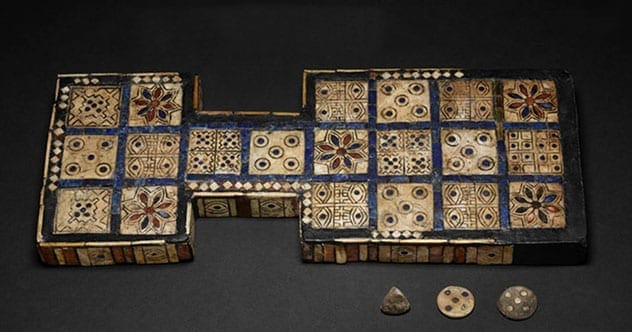Long before board games such as Monopoly, Yahtzee, Clue, and Candy Land were enjoyed by families on game night, ancient board games were thriving in parts of the world. The ancient Romans, Egyptians, and Chinese were creative in the ways they made boards and pieces from stones, rocks, and wood. Many of these games resemble modern games in the way they look and play. Here are ten ancient board games that inspired the board games of today.
Ludus Latrunculorum
Ludus Latrunculorum, which translates to Game of Mercenaries, is an ancient Roman strategic game. The game is similar to checkers and played on boards with grids of 7×7, 7×8, 8×8, 8×9, 9×9, or 9×10. Two players move their pieces forward and backwards across the board trying to capture their opponents pieces while protecting their own pieces. [1]
The ancient game of military tactics was first mentioned in the Roman writings of Varro (116-27 BC) in his book titled De Lingua Latina. His writing mainly mentioned the grid of the game board, but the rules were first found in the anonymous Roman poem Laus Pisonis, which was written in the 1st Century. Several Ludus Latrunculorum boards of different sizes and materials have been found in various places and can now be seen in museums.
Patolli
One of the oldest known board games in America is Patolli. The game was mostly played by a range of pre-Columbian Mesoamerican cultures, and it is even reported that Montezuma enjoyed watching the nobles play the game at court. The game was enjoyed by both commoners and nobles, and it was a game of strategy mixed with some luck.
Patolli was a game that focused on gambling. Players would bring the same number of items to gamble (usually six items), and they would inspect each other’s items before beginning. The object of the game is to move the six game pieces from the starting square to the ending square before the other player. The game is played until one player earns all of the other player’s items. Players were known to gamble away their money, blankets, precious stones, food, homes, and even their family and freedom. The gambling game would be so detrimental to some that the Spanish priests outlawed the game during the Spanish conquest of Mexico. [2]
Senet
Ancient Egypt introduced us to a board game known as senet, which means “Game of Passing.” It is one of the oldest known board games dating back to 3100 BC where fragments of boards were found in burials in Egypt.
The game board is made up of 30 squares that are evenly arranged in three rows of ten. There are two sets of pawns with at least five pawns each. The original game rules are still unknown, but there have been pieces of texts revealing parts of the rules. The rules have most likely changed over time, meaning the rules of modern senet sets don’t reflect those that were used in Ancient Egypt. [3]
The Royal Game of Ur
The Royal Game of Ur was widely popular across the Middle East and dates back to the early third millennium BC. The two-player strategy board game hit a spiritual high and was believed by many to reflect a player’s future and convey messages from the supernatural.
The race game is played using two sets of seven game pieces and a game board made up of two rectangular sets of boxes. You will need strategy and luck to dominate your opponent while trying to move your seven pieces along the course before the other player. The Game of Ur lost most of its popularity during the late antiquity, where many believed the game evolved into an early form of backgammon. [4]
Gyan Chauper
A popular dice game in India is known as gyan chauper, and the earliest versions of the game date back to the 10th century A.D. Back then, the game was played on a painted cloth called patas. The game was entertaining, but it was also played to instruct morality. The central theme of the ancient game was the liberation from bondage of passions. It is more popularly known in today’s society as Snakes and Ladders. [5]
In gyan chauper players start from the bottom of the game board and roll the dice in order to move forward according to the number that lands on the dice. The game is based entirely upon luck and is a simple race to the top while trying to avoid obstacles in the shape of snakes that hold players back. The board and gameplay have been slightly modified over time in different areas of the world today.
Alquerque
Alquerque is an abstract strategy board game that is believed to have originated in the Middle East. Abu al-Faraj al-Isfahani first mentioned the game in literature in his 24-volume work Kitab al-Aghani that was released in the 10th century. However, rules of the game were found in the 13th century Libro de los juegos by Alfonso X of Castile.
Before the game begins, each player places their 12 pieces on the two closest rows and in the two right spaces on the center row. The object of the game is to eliminate the other player’s pieces by jumping an opponent’s piece that is adjacent and the point beyond the piece is empty. Alquerque is considered to be the parent game of the U.S. version of checkers. [6]
Mehen
The ancient Egypt board game mehen was named in reference to a snake deity in ancient Egyptian religion. Evidence of mehen has been found dating from around 3000 BC until the end of the Old Kingdom around 2300 BC. Physical boards and game pieces have been found that mostly date to the Predynastic and Archaic periods.
The game board resembles a coiled snake that is divided into several rectangular spaces and game pieces were often made of stones. Game boards have been found with different numbers of segments, but it seems that the number of segments had little importance on the game play. The game pieces are believed to be formed into the shape of a lion or lioness and came in sets of three, four, five, or six along with a few small sphere-shaped pieces. The rules of mehen are entirely unknown today. [7]
Go
More than 2,500 years ago, the Chinese invented the abstract board game Go. The game of strategy is believed to be the oldest board game to be continuously played to the present day. A recent survey showed that more than 46 million people in the world know how to play Go, and over 20 million of them are current players. A majority of the current players live in East Asia.
Two players take turns placing their stones, black and white, on intersections of the board in order to start gameplay. Players must place stones on unoccupied intersections except for those forbidden by suicide and ko. A stone can not be moved once played, but it can be taken off the board if captured. Players may pass on their turn when they feel that nothing more can be accomplished, and the game ends when both players consecutively pass. The game is then scored to find out which player is victorious. Since Go is a competitive game in many parts of the world, many play the game professionally. [8]
Hounds and Jackals
Hounds and Jackals was a popular board game invented around 4,000 years ago in Ancient Egypt. The Bronze Age board game was once found in its entirety in a Theban tomb of the Egyptian pharaoh Amenemhat IV that dates to the 12th Dynasty. The complete gaming set that was found is preserved today at the Metropolitan Museum of Art in New York. [9]
Hounds and Jackals, also known as 58 Holes, is the modern name given to the game by Howard Carter, who is the man that found the complete set in the Egyptian tomb. The original name of the game is unknown. Players move their ten small sticks with either dog or jackal heads along the board that contains 29 holes on each player’s side of the board. The player that reaches the finish point with all their figures wins the game. The modern game of Cribbage features a similar board and may have derived from Hounds and Jackals.
Nine Men’s Morris
Have you ever noticed a game printed on the opposite of a checkerboard? If so, there is a good chance it was a board for nine men’s morris, also known as cowboy checkers. The strategy board game dates back to the Roman Empire, but it peaked in popularity in medieval England. Many game boards have been found carved into seats at English cathedrals in several cities.
The two-player game is one of strategy that can result in a draw with a perfect game from both players. The game board consists of twenty-four points across a grid. Each player starts with nine black or white pieces, and they work to remove their opponent’s pieces until they only have two remaining. Once a player has successfully completed that or blocked their opponent from making a legal move, the game ends. There are also variations of the game known as three men’s morris, six men’s morris, and twelve men’s morris which changes the board and number of pieces played. [10]
These ancient board games offer a glimpse into the past, showcasing the creativity and strategic thinking of ancient civilizations. From the Roman’s Ludus Latrunculorum to the Egyptian’s Senet, each game has its unique charm and historical significance. Many of these games laid the groundwork for the modern board games we enjoy today.
Which of these ancient games intrigues you the most? Leave your comment below!










